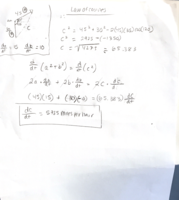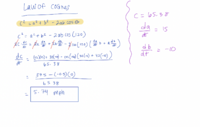blueroses12
New member
- Joined
- May 30, 2020
- Messages
- 4
Boat A is traveling away from the port in the direction 30degrees North of East (30 degrees above the positive x-axis) at a rate of 15 miles per hour. Boat B travels North and towards the port at a rate of 10 miles per hour. Find the rate of change of the distance between the two boats when Boat A is 45 miles from the port and Boat B is 30 miles from the port. Round your answer to two decimal places and make sure to include units.
Can someone check my work? I used the law of cosine to find the missing side. And then plugged everything in to find the rate of change of the distance between the two points. Also, I used negative 10mph for dB/dt since the distance of boat B is decreasing as its approaching the port.
Please let me know if I made a mistake somewhere. Thank you!
Can someone check my work? I used the law of cosine to find the missing side. And then plugged everything in to find the rate of change of the distance between the two points. Also, I used negative 10mph for dB/dt since the distance of boat B is decreasing as its approaching the port.
Please let me know if I made a mistake somewhere. Thank you!


